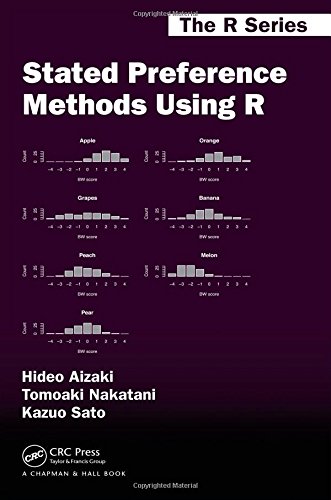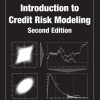Stated Preference Methods Using R 1st Edition by Hideo Aizaki, Tomoaki Nakatani, Kazuo Sato 0367834286 9780367834289
$50.00 Original price was: $50.00.$35.00Current price is: $35.00.
Stated Preference Methods Using R 1st Edition by Hideo Aizaki, Tomoaki Nakatani, Kazuo Sato – Ebook PDF Instant Download/Delivery: 0367834286, 9780367834289
Full download Stated Preference Methods Using R 1st Edition after payment

Product details:
ISBN 10: 0367834286
ISBN 13: 9780367834289
Author: Hideo Aizaki, Tomoaki Nakatani, Kazuo Sato
Stated Preference Methods Using R explains how to use stated preference (SP) methods, which are a family of survey methods, to measure people’s preferences based on decision making in hypothetical choice situations. Along with giving introductory explanations of the methods, the book collates information on existing R functions and packages as well
Stated Preference Methods Using R 1st Table of contents:
1 Introduction
1.1 Stated preference methods and the role of R
1.2 Objective of this book
1.3 Overview of CV, DCEs, and BWS
1.3.1 Contingent valuation
1.3.2 Discrete choice experiments
1.3.3 Best–worst scaling
1.4 Random utility theory and discrete choice models
1.4.1 Random utility theory
1.4.2 Discrete choice models
1.5 Summary of the rest of this book
2 Contingent Valuation
2.1 Introduction
2.2 Overview of contingent valuation
2.2.1 Elicitation formats
Single-bounded dichotomous choice
Double-bounded dichotomous choice
2.2.2 Bid design
2.2.3 Parametric estimation method
Parametric estimation of SBDC data
Parametric estimation of DBDC data
2.2.4 Nonparametric estimation method
Nonparametric estimation of SBDC data
Nonparametric estimation of DBDC data
2.3 An R package for analyzing SBDC and DBDC CV data
2.3.1 Overview of package DCchoice
2.3.2 Installing the DCchoice package
2.3.3 Loading the package
2.3.4 Preparing datasets
2.3.5 Example datasets
Datasets included in DCchoice
The Albemarle–Pamlico sounds survey data
The Exxon Valdez Oil Spill data
Kriström’s data
The NaturalPark data
2.4 Parametric estimation of WTP
2.4.1 Estimating WTP with SBDC data
Examples
Example code: A log-logistic model of the Natural Park data
Example code: A log-normal model of the Natural Park data
2.4.2 Estimating WTP with DBDC data
Example code: Log-logistic and log-normal models for the Albemarle–Pamlico sounds data
2.4.3 Constructing confidence intervals
The Krinsky and Robb method
The bootstrap method
Example code
2.5 Nonparametric estimation of WTP
2.5.1 Kriström’s nonparametric estimation of SBDC data
Replicating Kriström’s results
2.5.2 Kaplan–Meier–Turnbull estimation of SBDC data
Example code using the Natural Park data
Example code using the Exxon Valdez Oil Spill data
2.5.3 Kaplan–Meier–Turnbull estimation of DBDC data
Example code using the Natural Park data
Example code using the double-bounded version of the Exxon Valdez Oil Spill data
2.6 Concluding remarks
2.A Appendix
The Exxon Valdez Oil Spill data
3 Discrete Choice Experiments
3.1 Introduction
3.2 Overview of DCEs
3.2.1 Basic terms used in DCEs
3.2.2 Steps for implementing DCEs
Step 1: Examining a hypothetical situation and creating a DCE design
Step 2: Preparing and conducting a questionnaire survey
Step 3: Preparing a dataset and conducting the analysis
3.3 R functions for DCEs
3.3.1 Overview
3.3.2 Creating a DCE design
Example code and output
3.3.3 Converting a DCE design into questionnaire format
Example code and output
3.3.4 Creating a design matrix
Example code and output
3.3.5 Creating a dataset
Example code and output
3.3.6 Conducting statistical analysis
Example code and output
3.3.7 Calculating goodness-of-fit measures
Example code and output
3.3.8 Calculating MWTPs
Example code and output
3.3.9 Testing the difference between two independent MWTP distributions
Example code and output
3.4 Example DCEs using R
3.4.1 Unlabeled DCE example
3.4.2 Labeled design example
3.4.3 BDCE example
3.5 Concluding remarks
4 Best–Worst Scaling
4.1 Introduction
4.2 Outline of BWS
4.2.1 BWS basics
4.2.2 Steps in BWS
Step 1: Constructing choice sets
Step 2: Preparing a questionnaire survey
Step 3: Analyzing responses to questions
4.3 R functions for BWS
4.3.1 Overview
4.3.2 Constructing choice sets
Example code and output
4.3.3 Preparing BWS questions
Example code and output
4.3.4 Creating the dataset
Example code and output
4.3.5 Analyzing responses using the counting approach
Example code and output
4.3.6 Analyzing responses using the modeling approach
Example code and output
4.4 Example BWS using R
4.4.1 BWS based on a two-level OMED
4.4.2 BWS based on a BIBD
4.5 Concluding remarks
4.A Appendix: Profile case BWS and multiprofile case BWS
4.A.1 Profile case BWS
4.A.2 Multiprofile case BWS
5 Basic Operations in R
5.1 Introduction
5.2 Getting started with R
5.2.1 Obtaining and installing R
5.2.2 Starting and quitting R
5.2.3 Using R as a calculator
5.2.4 Changing appearance
5.2.5 Accessing help
5.3 Enhancing R
5.3.1 Installing contributed add-on packages
5.3.2 Reading source code
5.3.3 Loading source code
5.4 Importing and exporting data
5.4.1 File formats
5.4.2 Importing data from a CSV file
5.4.3 Exporting R objects
5.5 Manipulating vectors and matrices
5.5.1 Manipulating vectors
5.5.2 Manipulating matrices
5.5.3 Operations on indexes
5.5.4 Random number generation
5.6 Data and object types
5.6.1 Data types
5.6.2 Object types
5.6.3 Examples
5.7 Implementing linear regression
5.7.1 Conducting the analysis
5.7.2 Displaying and summarizing output
5.7.3 Creating dummy variables
5.7.4 Updating the model
5.8 Drawing figures
Appendix A Other Packages Related to This Book
A.1 Introduction
A.2 Contingent valuation
A.3 Discrete choice models
A.4 Cluster, component, and factor analysis
A.5 Conjoint analysis
Appendix B Examples of Contrivance in Empirical Studies
B.1 Introduction
B.2 Providing information to respondents
B.3 Using product/service samples
B.4 Cost–benefit analysis and valuation
B.5 Using SP study results in simulations
People also search for Stated Preference Methods Using R 1st:
stated preference method vs revealed preference
stated preferences vs revealed preferences
stated preference valuation methods
stated preference theory
Tags: Hideo Aizaki, Tomoaki Nakatani, Kazuo Sato, Stated



